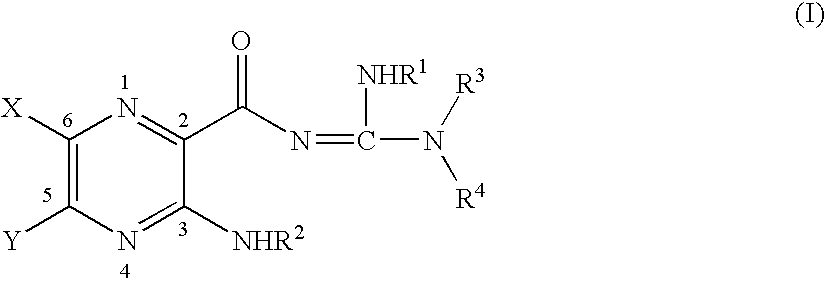Alaphatic pyrazinoylguanidine sodium channel blockers
a technology of pyrazinoylguanidine and sodium channel blocker, which is applied in the direction of drug composition, biocide, extracellular fluid disorder, etc., can solve the problems of inability to clear mucus from airway surfaces, inability to clear mucus reflects an imbalance between the amount of liquid, and the problem of initiating problems, so as to achieve less reversible, less reversible, and more potent
- Summary
- Abstract
- Description
- Claims
- Application Information
AI Technical Summary
Benefits of technology
Problems solved by technology
Method used
Image
Examples
example 1
Synthesis of N-(6-aminohexyl)-N′-(3,5-diamino-6-chloropyrazine-2-carbonyl)guanidine Dihydrochloride (PSA 18706)
[0527]
[0528]{6-[N′-(3,5-Diamino-6-chloropyrazine-2-carbonyl)guanidino]hexyl}carbamic acid tert-butyl ester (2a).
[0529]Compound 2a was synthesized from 1a, 6-aminohexylcarbamic acid tert-butyl ester (Scheme 1), in 90% yield using method D. 1H NMR (300 MHz, CD3OD): δ 1.42 (s, 9H), 1.46-1.65 (m, 8H), 3.04 (t, 2H), 3.22 (t, 2H). m / z (APCI): 429 [C17H29ClN8O3+H]+.
[0530]N-(6-Aminohexyl)-N′-(3,5-diamino-6-chloropyrazine-2-carbonyl)guanidine dihydrochloride (3a, PSA 18706).
[0531]Compound 3a was synthesized from compound 2a in 34% yield using method B. mp>240° C. 1H NMR (300 MHz, CD3OD): δ 1.42-1.54 (m, 4H), 1.65-1.78 (m, 4H), 2.94 (t (t, 2H). m / z (APCI): 329 [C12H21ClN8O+H]+.
example 2
Synthesis of N-(7-aminoheptyl)-N′-(3,5-diamino-6-chloropyrazine-2-carbonyl)guanidine (PSA 18705)
[0532]
[0533]Compound 3b (PSA 18705) was synthesized from heptane-1,7-diamine in 65% yield using method D. mp 185-187° C. (decomposed). 1H NMR (300 MHZ, CD3OD): δ 1.40-1.55 (m, 6H), 1.58-1.76 (m, 4H), 2.80 (t, 2H), 3.30 (m, 2H). m / z (ESI): 343 [C13H23ClN8O+H]+.
example 3
Synthesis of N-{7-[N′-(3,5-diamino-6-chloropyrazine-2-carbonyl)guanidino]heptyl}guanidine Dihydrochloride (PSA 19155)
[0534]
[0535]N-(7-Aminoheptyl)-[N′,N″-bis-(tert-butoxycarbonyl)]guanidine (6b)
[0536]Compound 6b was synthesized from heptane-1,7-diamine (Scheme 2) in 43% yield using method C. 1H NMR (300 MHz, CDCl3): δ 1.44-1.50 (m, 10H), 1.55 (s, 18H), 1.84 (t, 2H), 2.78 (t, 2H), 3.46 (t, 2H). m / z (ESI): 373 [C18H36N4O4+H]+.
[0537]N-{7-[N′-(3,5-Diamino-6-chloropyrazine-2-carbonyl)guanidino]heptyl}guanidine dihydrochloride (5b, PSA 19155).
[0538]Compound 6b was reacted with the Cragoe compound according to method D (Scheme 2). The product of the reaction, after chromatographic purification, was directly treated with concentrated HCl using method B to afford the desired compound 5b in 17% overall yield. mp 140-142° C. 1H NMR (300 MHz, CD3OD): δ 1.42-1.54 (m, 6H), 1.60-1.82 (m, 4H), 3.18 (t, 2H), 3.34 (m, 2H). m / z (ESI): 385 [C14H25ClN10O+H]+.
PUM
| Property | Measurement | Unit |
|---|---|---|
| size | aaaaa | aaaaa |
| size | aaaaa | aaaaa |
| size | aaaaa | aaaaa |
Abstract
Description
Claims
Application Information
 Login to View More
Login to View More - R&D
- Intellectual Property
- Life Sciences
- Materials
- Tech Scout
- Unparalleled Data Quality
- Higher Quality Content
- 60% Fewer Hallucinations
Browse by: Latest US Patents, China's latest patents, Technical Efficacy Thesaurus, Application Domain, Technology Topic, Popular Technical Reports.
© 2025 PatSnap. All rights reserved.Legal|Privacy policy|Modern Slavery Act Transparency Statement|Sitemap|About US| Contact US: help@patsnap.com



